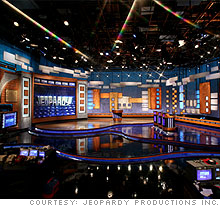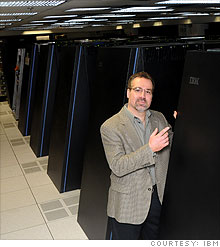Facing off against IBM's 'Jeopardy!' computer
Watson, IBM's language processing system, is still in development, but an appearance on the game show may give businesses ideas for its practical use.
 |
| Watson is set to appear on 'Jeopardy!' sometime in 2010. |
 |
| David Ferrucci, IBM's lead researcher on Watson, shows the massive scale of the Blue Gene/P computer that it takes to run Watson's language software. |
HAWTHORNE, New York (CNNMoney.com) -- I'm a bit intimidated entering IBM's research center in Hawthorne, New York. After all, the company's sales totaled $104 billion...yes, billion...last year.
So not only am I traveling into the heart of one of largest tech companies in the world, but I'm about to face off against Watson, the natural language processing system that is due to appear on the television quiz show "Jeopardy!" some time next year.
The sprawling complex is filled with rooms assigned generic numbers, separated by swaths of black, gray and blue-colored carpets. A quick right turn out of the elevator puts me in front of Lab 2SG85.
The lab is shoddier than I would have expected -- paneled walls, rickety desks and low ceilings with florescent lights, like it hadn't been updated since the 1970s.
In the small room where I'll be battling wits with Watson, there's a glowing red emergency electrical shut-off switch on the wall. (HAL, anyone?) There are algorithms scribbled on a white board that show how Watson arrives at a particular response.
The presentation, set up by IBM researcher David Ferrucci, isn't working. Ferrucci, who also heads up the Watson team, neglected to plug the projector into his ThinkPad laptop.
"You'd think we'd be wireless by now," he quips.
He plugs the projector in, and a Jeopardy! board pops up on the screen.
Alright. Ready to go. Finger on the buzzer. Watson picks geography for $400.
This should be easy, I'm thinking.
"Eighty percent of Algeria is covered by this desert."
I know this one! I buzz in quickly.
"Player two, Watson."
Huh?
"What is Sahara?" says the computer's simulated voice.
Too fast for me.
How Watson works. The computer and software system, named after Big Blue founder Thomas Watson, marks an impressive big step on the path toward being able to talk with computers.
Interestingly, the researchers did not load Watson up with countless databases, but rather taught it to search through text, and use context to "understand" how words relate to each other. For example, talking about a character in a novel is vastly different from talking about someone's personal character.
To get an answer, the computer considers many factors, from simple keyword matching and arithmetic, to complex, often ambiguous solutions like metonymy (substituting one concept for another, related one), and statistical paraphrasing ("Big Blue" is the same thing as "IBM").
Watson is able to do this in a fraction of a second because the program's hardware is an IBM Blue Gene/P -- one of the fastest super computers on the planet.
That doesn't mean it has all of the bugs worked out -- it responded with "Barbara Streisand" to the Jeopardy! answer "This Ziegfeld star was portrayed in the film 'Funny Girl.'" It was close, but the correct response is Fanny Brice. Streisand played Brice in the film. (It's okay, Watson, I didn't know the answer either.)
The other reason why IBM didn't just load Watson up with data is because it wants the technology to be accessible to any person or company looking for quick answers.
Watson, coming to a business near you. The possibilities for commercial use of the technology would seem endless. If Watson can answer complex Jeopardy! questions, then perhaps it could help doctors treat patients, bankers mitigate risk or consumers plan a dinner menu at a grocery store.
"The scalability of Watson combined with IBM's drive toward cloud computing could result in everything from answering children's queries to doing crisis management," said Richard Doherty, research director for the Envisioneering Group, which does some consulting for IBM. "Watson is going to be deployed, and not just to the Warren Buffetts and Bill Gateses of the world -- mom & pop shops will be able to use it too."
IBM (IBM, Fortune 500) certainly seems to thinks so.
"The future of Watson is to get it embedded in IBM's solutions and products to help customers deal effectively with unstructured content," said Ferrucci.
Experts agree, saying that Watson has the capability to help a broad range of customers.
Near universal access to Watson would, on the surface, seem unlikely, given the fact that few businesses have the wherewithal to buy the super computer it takes to run the program. Furthermore, Doherty estimates that the project costs roughly 5% to 10% of IBM's entire $6.3 billion R&D budget each year, putting Watson's three-year development price tag at roughly $900 million to $1.8 billion.
That's where cloud computing, or software as a service, comes in.
Doherty believes that IBM will be able to open up Watson's capabilities to all types of businesses and consumers by offering Watson on a kind of "time share." Got a question for Watson? Let IBM know, and for $100 per minute of use, they'll give you the answer.
And some businesses and agencies may want the whole thing to themselves. For instance, the U.S. Department of Energy is currently using a Watson test model for weather prediction.
Though competing on "Jeopardy!" will be challenging for IBM, it will also allow it to showcase Watson's capabilities for potential customers. Though IBM was reluctant to give a timeline, experts say Watson could be deployed as early as 2011. ![]()

